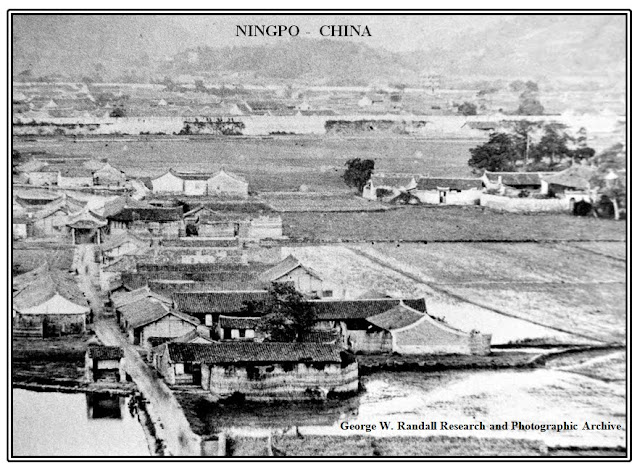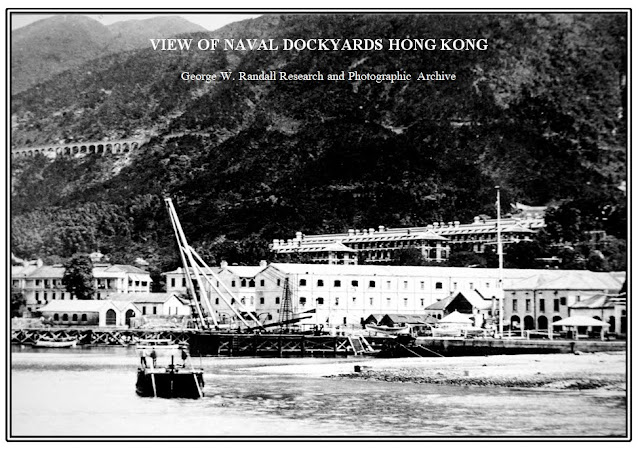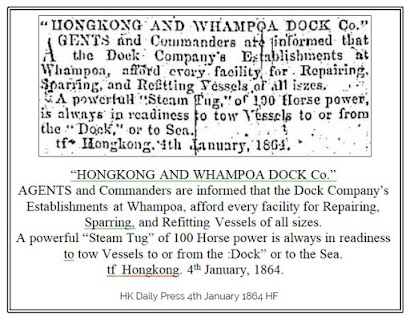NING-PO (today Ningbo)
Album XVI
* Image 4 * Size 10½ x 8½ inches.
NING-PO (Right: thatched roof ice houses.)
Album XVI * Image 4 * Detail from full size 10½ x 8½ inches.
NING-PO
Album XVI * Image 4 * Detail from full size 10½ x 8½ inches.
++++++++++++++++++++++++++++++++++++++++++++
++++++++++++++++++++++++++++++++++++++++++++
++++++++++++++++++++++++++++++++++++++++++++
++++++++++++++++++++++++++++++++++++++++++++
MAP OF HONG KONG DATED 1984
KOWLOON AND NEW
TERRITORIES TO THE NORTH OF VICTORIA HARBOUR
Hong Kong Island
was acquired in August 1842 by the Treaty of Nanking, the
Kowloon Peninsula was added in 1860, the
New Territories were leased in 1898 for ninety-nine years.
++++++++++++++++++++++++++++++++++++++++++++
VIEW OF HONG KONG HARBOUR LOOKING EAST
Album XVI
* Image 5 * Size 10½ x 9
inches.
Moored at her "Man o' War" anchorage in Hong Kong's Victoria Harbour is the British naval vessel Tamar (right centre). Launched in June 1863, the 2,812 ton burthen barque rigged steam troopship was equipped with a 500 HP steam engine driving a single propeller capable of a speed of 12 knots 320 feet in length with a beam of 45 feet Tamar carried three guns and for several decades served as the navy's base in Hong Kong until replaced by buildings ashore in 1897 - see IMAGE 6.
From 1897 to 1997 HMS Tamar was the name of the Royal Navy's base in Hong Kong. With the end of the ninety-nine year lease in 1997 the colony reverted to China.
HMS Tamar was scuttled off old Wan Chai Ferry Pier in 1941 to avoid the vessel falling into the hands of the Japanese during World War II.
Commodore-in-Charge,
Hong Kong, Sir George Thomas
Henry Boyes: June 1893 – July 1896. Prior to moving to Hong Kong (above) in 1897, a distance of 955 nautical miles (1,099 miles), HMS Tamar had been moored at Shanghai.
++++++++++++++++++++++++++++++++++++++++++++++++++++++
VIEW OF NAVAL DOCKYARDS HONG KONG
Album XVI * Image 6 * Detail from full size 10½ x 7 inches.
The new naval shore dockyard was commissioned in 1897
taking over from the 2,812 ton HMS Tamar whilst retaining the name.
From 1859 to 1959 there was a Royal Navy Dockyard located on the southern coast of Hong Kong Island, previously a victualling yard.
In addition from 1901 to 1959 the navy operated a dockyard at Kowloon, across Victoria Harbour on Kowloon Peninsula, which was an important coaling station.
The photograph above is from the George Warren Swire Collection and taken by Mr. Swire during his visit in 1907 when the dockyard was being expanded.
++++++++++++++++++++++++++++++++++++++++++++
HONG KONG HOTEL FROM WHARF
Album
XVI *
Image 7 * Size 10½ x 7 inches.

Overlooking the waterfront when it
opened in 1862 (before land reclamation)
the Hong Kong Hotel was modelled after
sumptuous hotels in London and run by Chinese management and staff.
As the
first luxury hotel in the Colony it soon earned an enviable reputation for service
and comfort.
The photograph depicts the six-storey north wing extension overlooking the waterfront with entrances on Pedder Street and Queen’s Road built in the 1880’s.
On the ground
floor of the hotel was a branch of Kuhn & Komor’s Oriental Art shop;
several of the magnificent Chinese and Japanese items in Kinloch Castle, such as the seven foot tall pair of Cloisonné vases and life-size bronze sea eating eagle on a tree stump, could well have been purchased here by
George Bullough.
Although the
hotel’s north wing burned down
in 1929, the original part remained open and
popular with the public until it eventually closed in 1952. The hotel ran a special launch from its own pier to ferry its guests to and from P & O liners.
The roofed wharf was called Pedder’s Pier, so named after William Pedder, (1801-1854),
First Lieutenant of the 660 ton burthen 184 foot long East India Company paddle frigate Nemesis, Great Britain's first ocean-going armed steam-driven iron warship.
Pedder became Hong Kong's first harbour master and marine magistrate.
Constructed of stone on timber pilings the pier was 195 feet in length and 40 feet in width having six steps down to the water.
It was demolished in the late
1890’s when a large reclamation scheme commenced.
++++++++++++++++++++++++++++++++++++++++++++

VIEW SHOWING CITY HALL
AND HONG KONG AND SHANGHAI BANK
Album
XVI *
Image 8 * Size 10½ x 8 inches.
City
Hall (left) and (right) from 1886-1933, the headquarters
of the Hong Kong and Shanghai Banking Corporation (HKBC) overlooking
the Hong Kong waterfront pre-land reclamation.
The
bank was founded in Hong Kong on the 3rd of March 1865 to
finance the rapidly expanding trade between China, India and Europe by thirty year old Thomas Sutherland.
Sir Thomas Sutherland, G.C.M.G., was born in Aberdeen, Scotland in August 1834.
Following graduating from Aberdeen University he was employed as a clerk in
the London office of the Peninsular and Oriental Steam Navigation Company before being promoted to the position of superintendent of the company’s Asian operation in British Hong Kong.
In 1863, aged, twenty-nine, in partnership with watchmaker and entrepreneur Douglas Lapraik and cotton, silk, tea and opium traders Jardine Matheson & Co., he co-founded the Hong Kong and Whampoa Dock Company, (at its peak the largest shipyard in Asia), and was appointed its first chairman. With his personal
experience in shipping with P. & O. and subsequent partnership with Lapraik and Jardine Matheson, Sutherland
quickly recognised the enormous potential, indeed urgent necessity, for banking facilities to expedite the rapidly
growing trade not only within Asia but the rest of the world.
A month after the
Hong Kong branch opened in March 1865 a second office opened in Shanghai. One hundred and fifty-four years later this British
multinational is the largest bank in Europe and seventh largest in the
world worth over £1.8 trillion.

QUEEN’S ROAD WEST SHOWING CHINESE TEA MERCHANTS
SHOPS CORNER OF POSSESSION STREET, HONG KONG
Album
XVI * Image 9 * Size 10¼
x 8½ inches.
Possession Street, the properties on each side occupied by native artisans and small shop keepers, has an important place in the history of Hong Kong for it was here on the 25th of January 1841 Sir Edward Belcher, C.B., K.C.B., of the British Navy aboard HMS Sulphur, a ten gun Hecla-class bomb vessel of 372 tons burthen, landed marking the beginning 150 years of Colonial rule with a
flag-raising ceremony.
At the time the street perched on the edge of the waterfront, but very
soon large projects of reclamation commenced so today 6% of Hong
Kong’s total area is land reclaimed from the sea.
++++++++++++++++++++++++++++++++++++++++++++
IDENTIFICATION ERROR:
Although included at this point in Album XVI and identified as “Chinese Houses - Hong Kong” this is incorrect, the photograph depicts Aden, today Yemen.
CHINESE HOUSES HONG KONG
Album XVI * Image 10 * Size 10 x 8½ inches.
I am informed by Bristol University the location is Aden, a vital coaling port of call to India and the Far East. SS Oceana, with George Bullough on board at the start of his three year long Grand World Tour, 1892-1895, called at Aden to re-coal in September 1892.
SEE ART TREASURES AT KINLOCH CASTLE:
Gibraltar,
Malta, Suez Canal, Aden to Colombo, Ceylon.
GEORGE BULLOUGH
WORLD TOUR 1892 - 1895 (Article 3)
++++++++++++++++++++++++++++++++++++++++++++

VIEW FROM SECOND HEIGHT OF TRAMWAY (TO THE PEAK)
OF THE MAN O’ WAR ANCHORAGE, HONG KONG
Album XVI * Image 11 * Size 10½ x 8½ inches.
Victoria
Peak, (occasionally referred to as Mount Austin), or the Peak as it
is
more popularly known, is on the western half of Hong Kong
island.
To
the early 19th century visitor, like much of Hong Kong, it was seen
as the “barren
rock” described by the then foreign secretary Lord Palmerston
when the
colony was established in 1841.
The
Peak was left untouched until 1860 when a signal station was built to
give
notice of the arrival
of mail and other shipping to the “barren
rock’s”
rapidly growing population.
VIEW FROM SECOND HEIGHT OF TRAMWAY (TO THE PEAK)
OF THE MAN O’ WAR ANCHORAGE, HONG KONG
Album XVI * Image 11 * Detail from full size 10½ x 8½ inches.
On a nearby plateau, under the direction of Hercules George Robert Robinson, G.C.M.G., P.C., 1st Baron Rosmead, fifth Governor of Hong Kong, a small military sanatorium was established and opened in the spring of 1862, access via a purpose built path. (SEE IMAGE 16)
A substantial building capable of caring for seventeen patients
it was not a success despite the much cooler air, 10 degrees C (14F) than at sea level and soon abandoned.
In 1867 Robinson's successor, Governor Sir Richard Graves MacDonnell, K.C.M.G., C.B., purchased the deserted building from the War Department
and converted it into the first Mountain Bungalow Lodge for the Governor's
use as a healthy alternative in summer to the lower levels.
A series of typhoons in 1868, 1874 and 1892 left the building so severely
damaged that by 1898 the only option was demolition.
FIRST STATION IN THE ASCENT OF THE PEAK TRAMWAY
Album XVI * Image 12 * Size 10¼ x 8¾ inches.
It was in 1881 that Alexander Findlay Smith, a former railway worker from Scotland, proposed construction of a Peak
Railway to Hong Kong’s eighth governor, Sir John Pope Hennessy, the required legislation
being passed two years later.
Permission granted Smith travelled widely in
Europe and America to become conversant with every existing method for mountain
ascent by rail.
Construction began in September 1885.
STEEPEST PORTION OF THE ASCENT - PEAK TRAMWAY - 1 IN 2
Album XVI * Image 13 * Size 10 x 8½ inches.
With a maximum gradient of 1 in 2 and each 23 foot (7 metre) long rail weighing
300-lbs. (136kg.) it was exceptionally dangerous and heavy work.
After thirty-two months on the 28th
of May 1888 the line was
opened by
Sir George William des Voeux, G.C.M.G., the Colony's tenth governor.
Its tram cars hauled by cable powered by a static steam engine it carried eight hundred
passengers on its first day and an estimated 150,000 in its first year.
The intervening years have seen a number of major improvements of track, machinery and rolling stock, plus, in 1989, a HK$60 million* upgrade which included a computer controlled electric drive system, today enables Alexander Findlay Smith’s tramway concept to carry more than seven million people each year.
* At the
1989 exchange rate HK$60 million was equal to UK£8,670,520.
In 2017 the
1989 UK£8,670,520 = UK£11,835,260 (UK Exchange Rate
and Inflation Calculator)
SECOND HEIGHT OF TRAMWAY TO THE PEAK - HONG KONG
Album XVI * Image 14 * Size 10½ x 8½ inches.
Smith’s partner was forty-nine year old Nathaniel Joseph Ede, Secretary 1871-1897
of the Union Insurance Society of Canton, who owned a house close-to the
Upper
Terminus called Dunheved.
Alexander Smith bought the property which was converted into the first Peak Hotel with bar, restaurant and twenty bedrooms.
The six station
funicular tramway runs 1,530 yards (1.4 kilometres) from Garden Road -the
lower terminus, to Victoria Peak, the upper terminus at 1,312 feet, some 490
feet below the
actual summit, with four intermediate stops, on a 4 ft. 1127⁄32 inch gauge
track.
(For comparison: British Rail gauge 4
ft. 8½ inches.)
JANUARY AND FEBRUARY 1884 VIEW OF BRIDGE NEAR TRAMWAY STATIONON THE PEAK SHOWING ICICLES NO ICE HAVING BEEN KNOWNIN SOUTH CHINA FOR 400 YEARS.
Album XVI * Image 15 * Detail from full size 10½ x 8½ inches.
There were already a few Hong Kong citizens living on the Peak, access being on foot, by horse, or sedan chair up narrow, winding paths.
The opening of the railway in 1888 led to a rush of affluent residents wishing to build homes in order to escape the oppressive summer heat and humidity at sea level, plus no doubt the crowding as the population fast approached 200,000.
WWW 4 May 2019
PEAK ROAD SHOWING HOSPITAL – HONG KONG
Album XVI * Image 16 * Size 10½ x 8½ inches
A signal station was built in 1860 to give notice of the arrival of mail and other shipping. The seventeen bed military sanatorium was opened in 1862, accessed by a specially built pathway. Despite the cooler and fresher air at over 1,800 feet the patients health appeared not to benefit. Abandoned, it was purchased five years later from the War Department the building became the first mountain bungalow.
PEAK ROAD SHOWING HOSPITAL – HONG KONG
Album XVI * Image 16 * Detail from full size 10½ x 8½ inches
PEAK ROAD SHOWING HOSPITAL – HONG KONG
Album XVI *
Image 16 * Detail from full size 10½ x 8½ inches
__________________________ * ________________________
The four intermediate stations, each with increasing panoramic views, were ideal for the establishment of new high class residential districts.
In ascending order:
Kennedy Road - named after Arthur Kennedy seventh governor of Hong Kong;
MacDonnell Road - after Richard Graves MacDonnell sixth Governor;
May Road - after Sir Francis Henry May fifteenth Governor;
and at 1,150 feet Barker Road, after former military commander,
General Sir George Digby Barker, G.C.B., acting administrator of Hong Kong in 1891.
++++++++++++++++++++++++++++++++++++++++++++
KINLOCH CASTLE WITH ITS CONTENTS IS AT RISK!!
Copyright * MAY MMXIX * George W. Randall Research and Photographic Archive.
Reviewed 28 November 2024.
| 



































































No comments:
Post a Comment